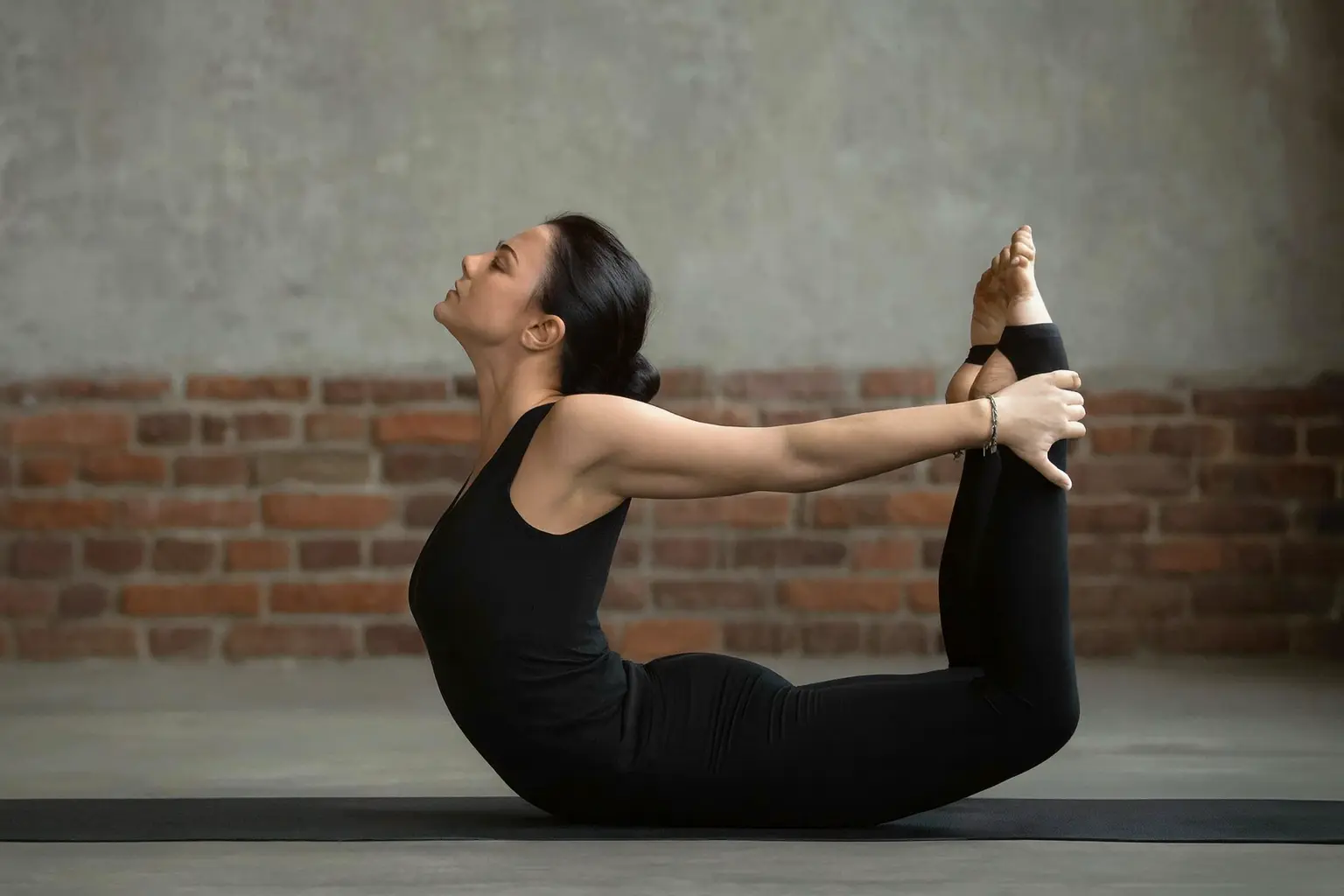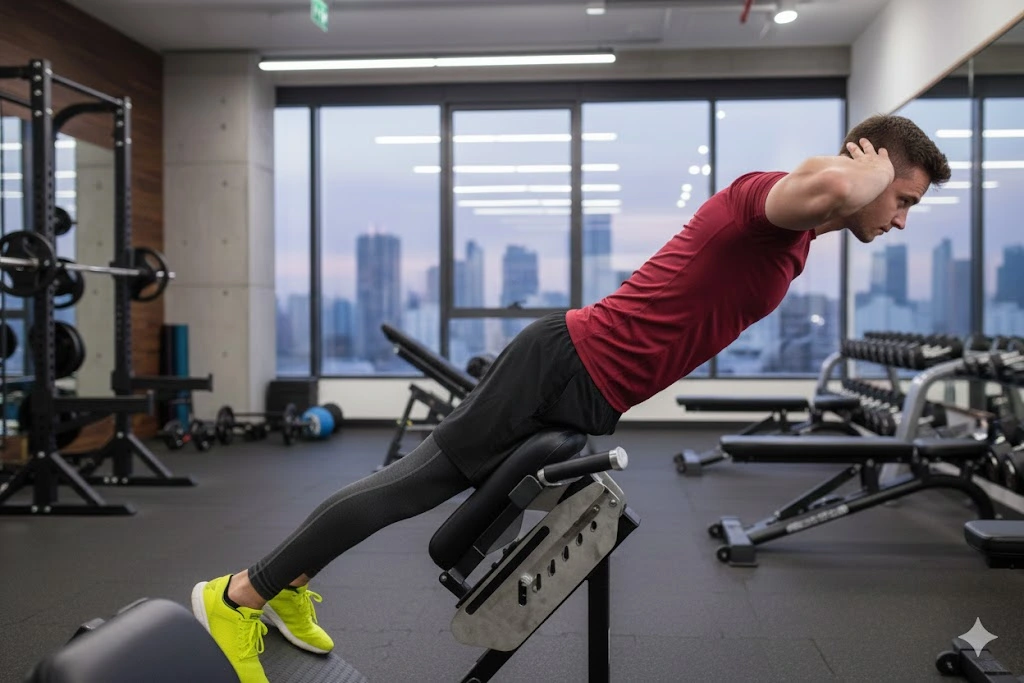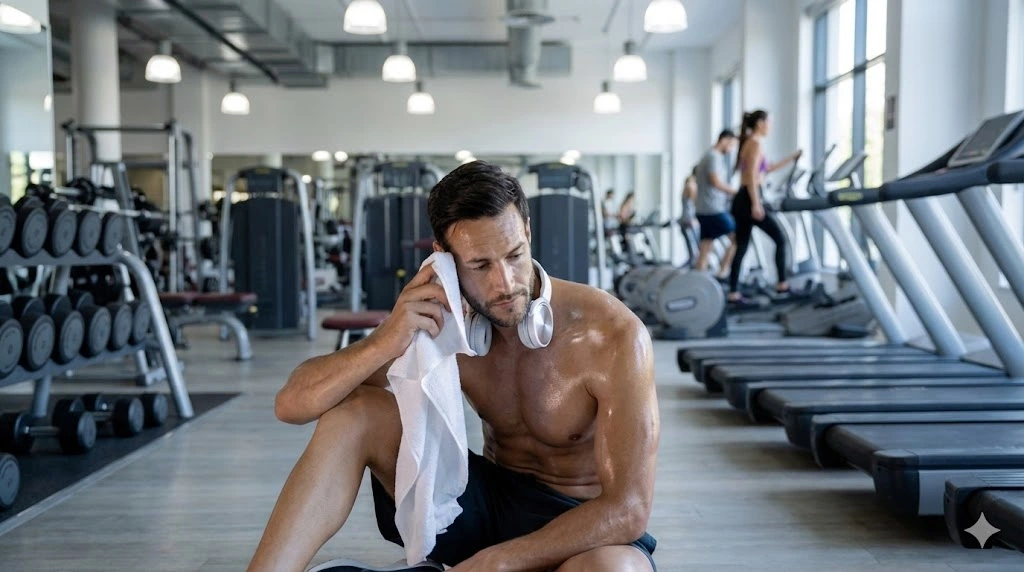Introduction
Bikram Yoga is a powerful form of yoga that combines discipline, structure, and heat to transform both the body and mind. Developed by Bikram Choudhury in the 1970s, this practice consists of a fixed series of 26 Bikram Yoga poses and two breathing exercises, performed in a heated room set to around 105°F (40°C) with controlled humidity. The heat is not just for intensity; it helps muscles stretch safely, increases blood flow, and encourages detoxification through sweat.
The Bikram Yoga poses are designed to target specific muscles, organs, and systems within the body. The practice begins with standing poses to improve strength, balance, and posture, and gradually transitions into floor poses that enhance flexibility and relaxation. Unlike other yoga styles that change sequences, Bikram Yoga adheres to the same order every time, enabling practitioners to measure their progress with precision. If you’re new to yoga, you can explore more fitness routines to build strength and flexibility before starting your Bikram journey.
The consistency of these Bikram Yoga 26 poses makes it ideal for both beginners and experienced yogis. Over time, it helps tone muscles, improve cardiovascular health, and build mental endurance. More importantly, the meditative focus of this routine encourages mindfulness, teaching you to stay calm and centered even in challenging situations.
Table of Contents
Overview of the 26 Bikram Yoga Poses
The 26 Bikram Yoga poses sequence is carefully designed to work every part of the body, muscles, joints, organs, and even the mind. Each pose is performed in a specific order, and together they form a complete system of movement, balance, and controlled breathing. Unlike random yoga sessions, Bikram Yoga follows a structured format where every position prepares you for the next one, ensuring gradual physical progress and mental focus.
The session usually begins with standing poses that build strength, coordination, and balance. These postures activate large muscle groups and help improve posture. As the class progresses, the sequence transitions into seated and floor poses, which focus on flexibility, spinal alignment, and deep relaxation. Finally, the two breathing exercises at the end help calm the nervous system and enhance oxygen flow throughout the body.
Because the room is heated, your body becomes more pliable, allowing you to stretch deeper and avoid injuries. This unique combination of heat, structure, and repetition sets Bikram Yoga apart from other styles, such as Hatha or Vinyasa. With each repetition of the 26 Bikram Yoga poses, your stamina, endurance, and confidence improve, making it not just a workout but a transformative experience. Whether you’re practicing in a studio or following a Bikram Yoga poses PDF at home, checking out a home workout can help you stay consistent and injury-free.
Whether you’re practicing in a studio or following a Bikram Yoga poses PDF at home, this sequence ensures you receive the same benefits worldwide. Every instructor, every class, and every session follows this exact same pattern, creating a sense of global unity among practitioners of Bikram Yoga.
List of the 26 Bikram Yoga Poses
The heart of Bikram Yoga lies in its 26 postures, each designed with a specific purpose to stretch, strengthen, and heal the body from the inside out. Every pose is performed in the same order to create balance between the body and mind. These movements stimulate blood circulation, improve flexibility, and promote overall physical and mental well-being.
Here’s the complete list of the 26 Bikram Yoga poses, along with their Sanskrit names and English translations:
- Standing Deep Breathing (Pranayama Series) – Expands lung capacity and prepares the body for the class.
- Half Moon Pose (Ardha Chandrasana) – Stretches and strengthens every muscle along the spine.
- Awkward Pose (Utkatasana) – Builds strength in the thighs, calves, and ankles.
- Eagle Pose (Garurasana) – Improves flexibility in joints and strengthens the lower body.
- Standing Head to Knee Pose (Dandayamana Janushirasana) – Increases concentration and strengthens the core.
- Standing Bow Pulling Pose (Dandayamana Dhanurasana) – Enhances balance, flexibility, and focus.
- Balancing Stick Pose (Tuladandasana) – Improves cardiovascular endurance and core stability.
- Standing Separate Leg Stretching Pose (Dandayamana Bibhaktapada Paschimottanasana) – Lengthens the hamstrings and spine.
- Triangle Pose (Trikonasana) – Strengthens legs, opens hips, and stretches the spine.
- Standing Separate Leg Head to Knee Pose (Dandayamana Bibhaktapada Janushirasana) – Stimulates abdominal organs and improves digestion.
- Tree Pose (Tadasana) – Encourages balance and stability through grounded focus.
- Toe Stand Pose (Padangustasana) – Improves balance and strengthens the ankles.
- Dead Body Pose (Savasana) – Allows the body to rest and reset between sequences.
- Wind Removing Pose (Pavanamuktasana) – Aids digestion and releases trapped gas.
- Sit Up (Pada-Hasthasana) – Activates abdominal muscles and boosts energy.
- Cobra Pose (Bhujangasana) – The Cobra Pose benefits include strengthening the spine and stimulating abdominal organs, essential for back flexibility.
- Locust Pose (Salabhasana) – Builds strength in the lower back and glutes.
- Full Locust Pose (Poorna Salabhasana) – Increases upper body strength and flexibility.
- Bow Pose (Dhanurasana) – Opens the chest and improves posture.
- Fixed Firm Pose (Supta Vajrasana) – Stretches thighs and knees while improving circulation.
- Half Tortoise Pose (Ardha Kurmasana) – Promotes relaxation and relieves tension.
- Camel Pose (Ustrasana) – Improves spinal flexibility and opens the heart.
- Rabbit Pose (Sasangasana) – Stretches the spine and relieves back tension.
Step-by-Step Guide to Each Pose
Performing each of the Bikram Yoga poses correctly is essential to receive the full benefits and prevent injuries. The precision and discipline of this practice are what make Bikram Yoga so effective. Let’s go through a simplified step-by-step guide to help you understand how to approach each posture properly.
Standing Deep Breathing (Pranayama Series)
Stand tall with feet together, spine straight, and arms at your sides. Interlock your fingers beneath your chin, inhale deeply through the nose, and lift your elbows high. As you exhale, tilt your head back and bring your elbows together in front of your chest. Repeat slowly to open the lungs and prepare your body for movement.
Half Moon Pose (Ardha Chandrasana)
Begin by standing straight with your hands over your head, palms pressed together. Slowly bend sideways from the waist, keeping your legs straight and your body in one line. Feel the stretch from your fingertips to your toes. This pose strengthens your obliques and improves spinal flexibility.
Awkward Pose (Utkatasana)
Stand with your feet hip-width apart, arms parallel to the floor. Slowly bend your knees as if you’re sitting on an invisible chair. Keep your back straight and engage your thighs. This pose builds lower-body strength and enhances stamina.
Eagle Pose (Garurasana)
Wrap your right arm under your left and cross one leg over the other while balancing. Sink slightly into your hips and focus your gaze forward. This posture strengthens your ankles, knees, and shoulders while improving coordination.
Standing Bow Pulling Pose (Dandayamana Dhanurasana)
Hold your right ankle with your right hand from the inside, and extend your left arm forward. Kick your right leg up and back as you bend forward, creating a graceful bow shape. It improves flexibility and concentration.
Triangle Pose (Trikonasana)
Step your feet wide apart, turn one foot out, and extend your arms horizontally. Reach toward your front foot and place your hand on your shin or floor while extending your other arm upward. This pose stretches your hips, spine, and legs while improving overall balance.
Cobra Pose (Bhujangasana)
Lie on your stomach, place your hands beneath your shoulders, and lift your chest by pressing into your palms. Keep your elbows close to your body. Cobra strengthens the spine and opens the chest, improving posture and flexibility.
Locust Pose (Salabhasana)
Lie flat on your stomach with arms under your body, palms facing down. As you inhale, lift your legs off the ground while keeping them straight. This pose strengthens the lower back, glutes, and legs.
Rabbit Pose (Sasangasana)
Kneel and grab your heels with your hands. Tuck your chin into your chest and slowly roll forward, bringing your forehead to your knees. Lift your hips toward the ceiling while keeping a firm grip on your heels. This posture stretches the spine and relieves back tension.
Bow Pose (Dhanurasana)
Lie on your stomach and grasp your ankles from behind. As you inhale, lift your chest and thighs off the floor, pulling your legs upward. You’ll form a bow shape, an excellent stretch for the entire front of the body, and a great energizer.
Spine Twisting Pose (Ardha Matsyendrasana)
Sit with one leg bent and cross the other foot over it. Place your opposite elbow outside the bent knee and gently twist your torso. This final stretching pose detoxifies internal organs and improves spinal flexibility.
Benefits of Bikram Yoga Poses
Practicing Bikram Yoga poses regularly brings a wide range of physical, mental, and emotional benefits. The heat, combined with the structured 26-pose sequence, works to detoxify the body, sharpen the mind, and create an overall sense of well-being. Below are the key benefits that make this yoga style so transformative.
1. Enhances Flexibility and Strength
The heated environment allows your muscles to stretch deeper and more safely. As you move through each of the 26 Bikram Yoga poses, your joints, ligaments, and tendons become more supple. Poses like the Standing Bow Pulling Pose and Triangle Pose strengthen the legs and core, while Cobra and Locust poses build spinal strength. Over time, you’ll notice greater flexibility, balance, and tone in your entire body. To complement your sessions, you can also explore yoga for flexibility and strength to target muscle balance and posture alignment.
2. Improves Circulation and Detoxification
The combination of intense stretching and sweating increases blood circulation and helps flush toxins from the system. Each posture in the Bikram Yoga sequence compresses and releases internal organs, improving the flow of oxygenated blood throughout the body. This internal “massage” supports the liver, kidneys, and digestive system, helping you feel lighter and more energized after each session.
3. Aids in Weight Loss and Metabolism Boost
Since Bikram Yoga is practiced in high heat, your heart rate rises, leading to greater calorie burn. Poses that engage large muscle groups, such as Awkward Pose and Standing Head to Knee Pose, activate your metabolism and tone lean muscle mass. With consistent practice, many people experience improved endurance and steady fat loss.
4. Builds Mental Focus and Discipline
Because the sequence is repetitive and structured, Bikram Yoga demands concentration and patience. Staying present through each of the Bikram Yoga 26 poses sharpens mental focus and builds resilience. The heat tests your willpower, teaching you how to stay calm and centered even under pressure, a skill that easily carries into daily life.
5. Reduces Stress and Increases Mindfulness
The meditative breathing and physical exertion work hand in hand to calm the nervous system. As you move through each pose, your mind begins to quiet down, leading to reduced anxiety and improved emotional stability. Many practitioners describe it as a moving meditation that leaves them mentally refreshed and peaceful.
6. Improves Posture and Spinal Health
Postures like Half Moon Pose, Cobra, and Rabbit Pose help realign the spine and strengthen the back muscles. This reduces tension and pain caused by poor posture or sedentary lifestyles. Over time, the practice encourages a naturally upright and confident stance.
7. Promotes Overall Health and Longevity
Beyond the physical, Bikram Yoga supports a deeper sense of well-being. The consistent routine improves lung capacity, enhances digestion, balances hormones, and boosts immunity. Regular practitioners often report better sleep, improved focus, and a more positive outlook on life.
In short, Bikram Yoga poses and their benefits go beyond the mat. The 90-minute sequence becomes a full-body therapy, cleansing, strengthening, and revitalizing you from the inside out.
The Bikram Yoga Sequence Explained
The Bikram Yoga sequence is not random, it’s a scientifically designed flow that targets every part of your body in a precise order. Each of the 26 Bikram Yoga poses builds on the previous one, creating a rhythm that enhances strength, flexibility, and focus. This methodical structure is what makes Bikram Yoga both challenging and deeply therapeutic.
The sequence starts with standing postures that warm up the muscles and improve balance. These include poses like Half Moon, Awkward, Eagle, and Standing Bow, which focus on alignment, endurance, and concentration. Standing poses also strengthen your legs and increase blood circulation to prepare the body for the floor sequence.
Once the body is warmed up, the class transitions to floor poses such as Cobra, Locust, and Rabbit. These postures are designed to heal and strengthen the spine while relaxing the mind. The combination of compression and stretching stimulates internal organs, aiding digestion and detoxification.
Every class ends with a breathing exercise known as Kapalbhati in Vajrasana, or “Blowing in Firm Pose.” This helps regulate oxygen flow, improves lung capacity, and promotes mental clarity. The sequence as a whole enhances the body’s natural functions by compressing, stretching, and releasing every major muscle group and organ.
One of the most fascinating aspects of the Bikram Yoga 26 poses sequence is how repetition leads to transformation. By practicing the same order every session, your body adapts, your stamina improves, and your awareness deepens. Over time, this structured flow becomes meditative, allowing you to find stillness even amidst physical intensity.
Common Mistakes in Bikram Yoga (and How to Avoid Them)
Although Bikram Yoga poses are practiced in a structured manner, beginners often make minor mistakes that can impact their progress or cause discomfort. Here are some of the most common ones, and how to correct them:
- Skipping Hydration – Practicing in a heated room means you’ll sweat a lot. Many beginners forget to hydrate properly before and after class. Make sure to drink plenty of water throughout the day and add electrolytes if needed. Staying hydrated before and after class is crucial. Explore our guide on nutrition for yoga practitioners to maintain energy and prevent fatigue.
- Overstretching Too Soon – The heat can make you feel more flexible than you actually are. Avoid pushing your muscles beyond their natural range to prevent strain. Move gradually and listen to your body’s limits.
- Improper Breathing – Holding your breath during challenging poses is a common issue. Focus on deep, steady breaths, inhaling through the nose and exhaling through the mouth, to maintain calm and stamina.
- Incorrect Alignment – Small posture errors, like locked knees or rounded shoulders, can reduce the effectiveness of poses such as Triangle Pose or Standing Bow Pulling Pose. Take time to align properly before deepening the stretch.
- Neglecting Rest Between Poses – The brief relaxation moments, like in Savasana (Dead Body Pose), are not optional. They help reset your circulation and prepare your body for the next posture. Skipping them leads to fatigue and dizziness.
- Judging Progress Too Quickly – Bikram Yoga is about patience and persistence. Don’t compare yourself to others in the room. Progress comes through consistency, not competition.
- Ignoring the Heat’s Impact – The heat can intensify your heart rate and breathing. If you ever feel dizzy, take a knee or sit down, it’s not a failure but part of learning how to regulate your body.
By being mindful of these mistakes, you’ll make faster progress and enjoy the full benefits of the Bikram Yoga 26 poses sequence safely. Remember: alignment, breath, and patience are your best teachers in the hot room.
Bikram Yoga Posters, Charts & Resources
Having the right visual aids and learning materials can make your Bikram Yoga journey smoother and more engaging. Since the Bikram Yoga poses sequence always follows the same 26 postures, using posters, charts, and PDFs helps practitioners stay consistent and accurate, even when practicing alone.
Bikram Yoga Poses Poster
A Bikram Yoga poses poster visually presents all 26 postures in order, usually with their English and Sanskrit names. It helps you remember alignment and posture details without having to pause mid-practice. Hanging a poster near your mat is a great way to stay focused and motivated during each session.
Bikram Yoga Poses PDF
A Bikram Yoga poses PDF serves as a handy digital guide with pictures, names, and short instructions for each posture. You can print it out, keep it on your phone, or use it during travel. It’s especially useful for beginners who want to follow the sequence step by step at home.
Yoga Pose Charts
Beyond Bikram, yoga pose charts and asana lists show how these postures connect to broader yoga traditions. They help you understand which muscles each pose targets and how Bikram Yoga evolved from Hatha Yoga. Charts labeled “26 hot yoga poses” or “yoga positions chart” are perfect for quick visual reference.
FAQs About Bikram Yoga Poses
Q1. How many poses are in Bikram Yoga?
There are 26 Bikram Yoga poses and two breathing exercises performed in every class.
Q2. Is Bikram Yoga good for beginners?
Yes, it’s beginner-friendly. The sequence is fixed, so you can easily learn and improve with regular practice.
Q3. Why is Bikram Yoga done in a heated room?
The heat helps muscles stretch safely, improves circulation, and promotes detoxification through sweat.
Q4. How often should I practice Bikram Yoga?
Practicing 3–4 times a week is ideal for strength, flexibility, and focus.
Q5. Can I do Bikram Yoga at home?
Yes, you can follow a Bikram Yoga poses PDF or online guide, though practicing in a heated environment is recommended for full benefits.
Conclusion
Bikram Yoga is much more than just a workout, it’s a powerful journey of discipline, endurance, and inner balance. The 26 Bikram Yoga poses combine strength, flexibility, and mindfulness in a sequence designed to challenge and heal the body from within. Practiced in a heated room, it enhances circulation, boosts metabolism, and helps the body release toxins while sharpening mental focus.
Whether you’re following the Bikram Yoga poses sequence in a studio or using a Bikram Yoga poses PDF at home, consistency is key. Each session brings you closer to better posture, deeper awareness, and a calmer mind. With time, you’ll notice not only physical transformation but also mental clarity and emotional balance, the true essence of yoga.
So, unroll your mat, stay hydrated, and let the Bikram Yoga 26 poses guide you toward strength, focus, and serenity. Your journey starts with the first pose, and continues with every breath.






One Response
This was time well spent reading.